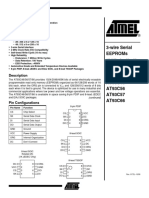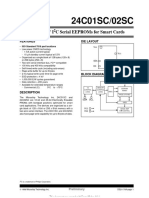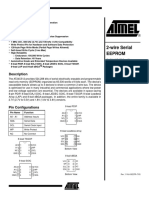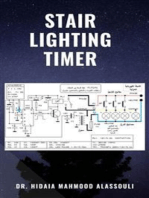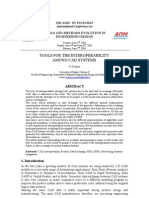HT24LC02: 2K 2-Wire CMOS Serial EEPROM
HT24LC02: 2K 2-Wire CMOS Serial EEPROM
Uploaded by
vetchboyCopyright:
Available Formats
HT24LC02: 2K 2-Wire CMOS Serial EEPROM
HT24LC02: 2K 2-Wire CMOS Serial EEPROM
Uploaded by
vetchboyOriginal Title
Copyright
Available Formats
Share this document
Did you find this document useful?
Is this content inappropriate?
Copyright:
Available Formats
HT24LC02: 2K 2-Wire CMOS Serial EEPROM
HT24LC02: 2K 2-Wire CMOS Serial EEPROM
Uploaded by
vetchboyCopyright:
Available Formats
HT24LC02
2K 2-Wire CMOS Serial EEPROM
Features
· Operating voltage: 2.4V~5.5V · 8-byte Page write modes
· Low power consumption · Write operation with built-in timer
- Operation: 5mA max. · Hardware controlled write protection
- Standby: 5mA max. · 40-year data retention
6
· Internal organization · 10 erase/write cycles per word
- 2K (HT24LC02): 256´8 · 8-pin DIP/SOP package
· 2-wire serial interface · 8-pin TSSOP (HT24LC02 only)
· Write cycle time: 5ms max. · Commerical temperature range
· Automatic erase-before-write operation (0°C to +70°C)
· Partial page write allowed
General Description
The HT24LC02 is a 2K-bit serial read/write low power and low voltage operation are essen-
non-volatile memory device using the CMOS tial. Up to eight HT24LC02 devices may be con-
floating gate process. Its 2048 bits of memory nected to the same two-wire bus. The
are organized into 256 words and each word is 8 HT24LC02 is guaranteed for 1M erase/write cy-
bits. The device is optimized for use in many in- cles and 40-year data retention.
dustrial and commercial applications where
Block Diagram Pin Assignment
A 0 1 8 V C C
S C L I/O H V P u m p A 1 2 7 W P
C o n tro l
S D A A 2 3 6 S C L
L o g ic
V S S 4 5 S D A
X
D E E P R O M H T 2 4 L C 0 2
M e m o ry E A rra y 8 D IP /S O P /T S S O P
W P C o n tro l C
L o g ic
P a g e B u f
Y D E C
A d d re s s
A 0 ~ A 2 S e n s e A M P
C o u n te r
R /W C o n tro l
V C C
V S S
1 November 16, 2000
HT24LC02
Pin Description
Pin Name I/O Description
A0~A2 I Address inputs
SDA I/O Serial data inputs/output
SCL I Serial clock data input
WP I Write protect
VSS ¾ Negative power supply
VCC I Positive power supply
Absolute Maximum Ratings
Operating Temperature (Commercial) .................................................................................0°C to 70°C
Storage Temperature .......................................................................................................-50°C to 125°C
Applied VCC Voltage with Respect to VSS ......................................................................-0.3V to 6.0V
Applied Voltage on any Pin with Respect to VSS ....................................................-0.3V to VCC+0.3V
Note: These are stress ratings only. Stresses exceeding the range specified under ²Absolute Maxi-
mum Ratings² may cause substantial damage to the device. Functional operation of this device
at other conditions beyond those listed in the specification is not implied and prolonged expo-
sure to extreme conditions may affect device reliability.
D.C. Characteristics Ta=0°C to 70°C
Test Conditions
Symbol Parameter Min. Typ. Max. Unit
VCC Conditions
VCC Operating Voltage ¾ ¾ 2.4 ¾ 5.5 V
ICC1 Operating Current 5V Read at 100kHz ¾ ¾ 2 mA
ICC2 Operating Current 5V Write at 100kHz ¾ ¾ 5 mA
VIL Input Low Voltage ¾ ¾ -1 ¾ 0.3VCC V
VIH Input High Voltage ¾ ¾ 0.7VCC ¾ VCC+0.5 V
VOL Output Low Voltage 2.4V IOL=2.1mA ¾ ¾ 0.4 V
ILI Input Leakage Current 5V VIN=0 or VCC ¾ ¾ 1 mA
ILO Output Leakage Current 5V VOUT=0 or VCC ¾ ¾ 1 mA
ISTB1 Standby Current 5V VIN=0 or VCC ¾ ¾ 5 mA
ISTB2 Standby Current 2.4V VIN=0 or VCC ¾ ¾ 4 mA
CIN Input Capacitance (See Note) ¾ f=1MHz 25°C ¾ ¾ 6 pF
COUT Output Capacitance (See Note) ¾ f=1MHz 25°C ¾ ¾ 8 pF
Note: These parameters are periodically sampled but not 100% tested
2 November 16, 2000
HT24LC02
A.C. Characteristics Ta=0°C to 70°C
Standard Mode* VCC=5V±10%
Symbol Parameter Remark Unit
Min. Max. Min. Max.
fSK Clock Frequency ¾ ¾ 100 ¾ 400 kHz
tHIGH Clock High Time ¾ 4000 ¾ 600 ¾ ns
tLOW Clock Low Time ¾ 4700 ¾ 1200 ¾ ns
tr SDA and SCL Rise Time Note ¾ 1000 ¾ 300 ns
tf SDA and SCL Fall Time Note ¾ 300 ¾ 300 ns
After this period
tHD:STA START Condition Hold
the first clock 4000 ¾ 600 ¾ ns
Time
pulse is generated
Only relevant for
tSU:STA START Condition
repeated START 4000 ¾ 600 ¾ ns
Setup Time
condition
tHD:DAT Data Input Hold Time ¾ 0 ¾ 0 ¾ ns
tSU:DAT Data Input Setup Time ¾ 200 ¾ 100 ¾ ns
tSU:STO STOP Condition Setup
¾ 4000 ¾ 600 ¾ ns
Time
tAA Output Valid from
¾ ¾ 3500 ¾ 900 ns
Clock
Time in which the
bus must be free
tBUF Bus Free Time before a new 4700 ¾ 1200 ¾ ns
transmission can
start
Input Filter Time
tSP Noise suppression
Constant (SDA and SCL ¾ 100 ¾ 50 ns
time
Pins)
tWR Write Cycle Time ¾ ¾ 5 ¾ 5 ms
Note: These parameters are periodically sampled but not 100% tested
* The standard mode means VCC=2.4V to 5.5V
For relative timing, refer to timing diagrams
3 November 16, 2000
HT24LC02
Functional Description
· Serial clock (SCL) line is high. Changes in data line while the
The SCL input is used for positive edge clock clock line is high will be interpreted as a
data into each EEPROM device and negative START or STOP condition.
edge clock data out of each device. · Start condition
· Serial data (SDA) A high-to-low transition of SDA with SCL
The SDA pin is bidirectional for serial data high is a start condition which must precede
transfer. The pin is open-drain driven and any other command (refer to Start and Stop
may be wired-OR with any number of other Definition Timing diagram).
open-drain or open collector devices. · Stop condition
· A0, A1, A2 A low-to-high transition of SDA with SCL
The A2, A1 and A0 pins are device address in- high is a stop condition. After a read se-
puts that are hard wired for the HT24LC02. quence, the stop command will place the
As many as eight 2K devices may be ad- EEPROM in a standby power mode (refer to
dressed on a single bus system (the device ad- Start and Stop Definition Timing Diagram).
dressing is discussed in detail under the · Acknowledge
Device Addressing section).
All addresses and data words are serially
· Write protect (WP) transmitted to and from the EEPROM in
The HT24LC02 has a write protect pin that 8-bit words. The EEPROM sends a zero to ac-
provides hardware data protection. The write knowledge that it has received each word.
protect pin allows normal read/write opera- This happens during the ninth clock cycle.
tions when connected to the VSS. When the
D a ta a llo w e d
write protect pin is connected to Vcc, the write to c h a n g e
protection feature is enabled and operates as S D A
shown in the following table.
WP Pin
Protect Array S C L
Status S ta rt A d d re s s o r S to p
c o n d itio n a c k n o w le d g e c o n d itio n
At VCC Full Array (2K) v a lid
At VSS Normal Read/Write Operations
Device addressing
Memory organization The 2K EEPROM devices all require an 8-bit
device address word following a start condition
· HT24LC02, 2K Serial EEPROM to enable the chip for a read or write operation.
Internally organized with 256 8-bit words, The device address word consist of a mandatory
the 2K requires an 8-bit data word address for one, zero sequence for the first four most signif-
random word addressing. icant bits (refer to the diagram showing the De-
vice Address). This is common to all the
Device operations EEPROM device.
· Clock and data transition The next three bits are the A2, A1 and A0 de-
Data transfer may be initiated only when the vice address bits for the 2K EEPROM. These
bus is not busy. During data transfer, the data three bits must compare to their corresponding
line must remain stable whenever the clock hard-wired input pins.
4 November 16, 2000
HT24LC02
The 8th bit of device address is the read/write A page write is initiated the same as byte
operation select bit. A read operation is initi- write, but the microcontroller does not send a
ated if this bit is high and a write operation is stop condition after the first data word is
initiated if this bit is low. clocked in. Instead, after the EEPROM ac-
If the comparison of the device address succeed knowledges the receipt of the first data word,
the EEPROM will output a zero at ACK bit. If not, the microcontroller can transmit up to seven
the chip will return to a standby state. more data words. The EEPROM will respond
with a zero after each data word received. The
1 0 1 0 A 2 A 1 A 0 R /W microcontroller must terminate the page
write sequence with a stop condition.
D e v ic e A d d r e s s
The data word address lower three (2K) bits
are internally incremented following the re-
Write operations ceipt of each data word. The higher data word
· Byte write address bits are not incremented, retaining
the memory page row location (refer to Page
A write operation requires an 8-bit data word
write timing).
address following the device address word
and acknowledgment. Upon receipt of this ad- · Acknowledge polling
dress, the EEPROM will again respond with a Since the device will not acknowledge during
zero and then clock in the first 8-bit data a write cycle, this can be used to determine
word. After receiving the 8-bit data word, the when the cycle is complete (this feature can be
EEPROM will output a zero and the address- used to maximize bus throughput). Once the
ing device, such as a microcontroller, must stop condition for a write command has been
terminate the write sequence with a stop con- issued from the master, the device initiates
dition. At this time the EEPROM enters an the internally timed write cycle. ACK polling
i n t e r na l l y - ti m ed w r i te c y c l e t o t h e can be initiated immediately. This involves
non-volatile memory. All inputs are disabled the master sending a start condition followed
during this write cycle and EEPROM will not by the control byte for a write command
respond until the write is completed (refer to (R/W=0). If the device is still busy with the
Byte write timing). write cycle, then no ACK will be returned. If
· Page write the cycle is completed, then the device will re-
turn the ACK and the master can then pro-
The 2K EEPROM is capable of an 8-byte page
ceed with the next read or write command.
write.
B y te w r ite tim in g
D e v ic e a d d r e s s W o rd a d d re s s D A T A
S D A S A 2 A 1 A 0 P
S ta rt R /W A C K A C K
A C K
S to p
P a g e w r ite tim in g
D e v ic e a d d r e s s W o rd a d d re s s D A T A n D A T A n + 1 D A T A n + x
S D A S P
S ta rt A C K A C K A C K A C K
S to p
5 November 16, 2000
HT24LC02
· Write protect
S e n d W r ite C o m m a n d
The HT24LC02 can be used as a serial ROM
when the WP pin is connected to VCC. Pro-
gramming will be inhibited and the entire S e n d S to p C o n d itio n
to In itia te W r ite C y c le
memory will be write-protected.
· Read operations
S e n d S ta rt
Read operations are initiated the same way
as write operations with the exception that
S e n d C o tr o ll B y te
the read/write select bit in the device address w ith R /W = 0
word is set to one. There are three read opera-
tions: current address read, random address
read and sequential read. N o
(A C K = 0 )?
· Current address read
The internal data word address counter Y e s
maintains the last address accessed during N e x t O p e r a tio n
the last read or write operation, incremented
by one. This address stays valid between op- Acknowledge polling flow
erations as long as the chip power is main-
tained. The address roll over during read
from the last byte of the last memory page to · Random read
the first byte of the first page. The address A random read requires a dummy byte write
roll over during write from the last byte of the sequence to load in the data word address
current page to the first byte of the same which is then clocked in and acknowledged by
page. Once the device address with the the EEPROM. The microcontroller must then
read/write select bit set to one is clocked in generate another start condition. The
and acknowledged by the EEPROM, the cur- microcontroller now initiates a current ad-
rent address data word is serially clocked out. dress read by sending a device address with
The microcontroller does not respond with an the read/write select bit high. The EEPROM
input zero but generates a following stop con- acknowledges the device address and serially
dition (refer to Current read timing). clocks out the data word. The microcontroller
does not respond with a zero but does gener-
ates a following stop condition (refer to Ran-
dom read timing).
C u r r e n t r e a d tim in g
D e v ic e a d d r e s s D A T A
S to p
S D A S A 2 A 1 A 0 P
S ta rt A C K N o A C K
R a n d o m r e a d tim in g
D e v ic e a d d r e s s W o rd a d d re s s D e v ic e a d d r e s s D A T A
S to p
S D A S A 2 A 1 A 0 S P
A C K A C K A C K N o A C K
S ta rt S ta rt
6 November 16, 2000
HT24LC02
· Sequential read
Sequential reads are initiated by either a cur- words. When the memory address limit is
rent address read or a random address read. Af- reached, the data word address will roll over
ter the microcontroller receives a data word, it and the sequential read continues. The sequen-
responds with an acknowledgment. As long as tial read operation is terminated when the
the EEPROM receives an acknowledgment, it microcontroller does not respond with a zero
will continue to increment the data word ad- but generates a following stop condition.
dress and serially clock out sequential data
S e q u e n tia l r e a d tim in g
D e v ic e a d d r e s s D A T A n D A T A n + 1 D A T A n + x
S D A S P
S ta rt A C K A C K A C K
S to p
Timing Diagrams
tf tr tH IG H
tL O W
S C L
tS U :S T A tH D :S T A tS U :D A T tS U :S T O
tH D :D A T
S D A tS P
tB U F
tA A
S D A
V a lid V a lid
O U T
S C L
S D A 8 th b it A C K
W o rd n tW R
S to p S ta rt
C o n d itio n C o n d itio n
Note: The write cycle time tWR is the time from a valid stop condition of a write sequence to the end
of the valid start condition of sequential command.
7 November 16, 2000
HT24LC02
Holtek Semiconductor Inc. (Headquarters)
No.3, Creation Rd. II, Science-based Industrial Park, Hsinchu, Taiwan
Tel: 886-3-563-1999
Fax: 886-3-563-1189
Holtek Semiconductor Inc. (Taipei Office)
11F, No.576, Sec.7 Chung Hsiao E. Rd., Taipei, Taiwan
Tel: 886-2-2782-9635
Fax: 886-2-2782-9636
Fax: 886-2-2782-7128 (International sales hotline)
Holtek Semiconductor (Hong Kong) Ltd.
RM.711, Tower 2, Cheung Sha Wan Plaza, 833 Cheung Sha Wan Rd., Kowloon, Hong Kong
Tel: 852-2-745-8288
Fax: 852-2-742-8657
Holtek Semiconductor (Shanghai) Inc.
7th Floor, Building 2, No.889, Yi Shan Rd., Shanghai, China
Tel: 021-6485-5560
Fax: 021-6485-0313
Holmate Semiconductor, Inc.
48531 Warm Springs Boulevard, Suite 413, Fremont, CA 94539
Tel: 510-252-9880
Fax: 510-252-9885
Copyright Ó 2000 by HOLTEK SEMICONDUCTOR INC.
The information appearing in this Data Sheet is believed to be accurate at the time of publication. However, Holtek
assumes no responsibility arising from the use of the specifications described. The applications mentioned herein are
used solely for the purpose of illustration and Holtek makes no warranty or representation that such applications
will be suitable without further modification, nor recommends the use of its products for application that may pres-
ent a risk to human life due to malfunction or otherwise. Holtek reserves the right to alter its products without prior
notification. For the most up-to-date information, please visit our web site at http://www.holtek.com.tw.
8 November 16, 2000
You might also like
- Diagnostic Test TLE 7Document4 pagesDiagnostic Test TLE 7Khunyne50% (6)
- Electricity and Magnetism II - Jackson Homework 3Document4 pagesElectricity and Magnetism II - Jackson Homework 3Ale Gomez100% (1)
- InstallationGuide SQL 621IDocument182 pagesInstallationGuide SQL 621INguyễn Viết HoànNo ratings yet
- FM Global Property Loss Prevention Data Sheets: 1.0 SCOPEDocument23 pagesFM Global Property Loss Prevention Data Sheets: 1.0 SCOPESANJAY KUMAR M A0% (1)
- HT24LC02: CMOS 2K 2-Wire Serial EEPROMDocument12 pagesHT24LC02: CMOS 2K 2-Wire Serial EEPROMvetchboyNo ratings yet
- HT24LC02: CMOS 2K 2-Wire Serial EEPROMDocument12 pagesHT24LC02: CMOS 2K 2-Wire Serial EEPROMhcarcaroNo ratings yet
- 24 LC 04Document8 pages24 LC 04mjankebnuNo ratings yet
- Drive MotorDocument5 pagesDrive MotorHenrique Flávio Sucupira PaivaNo ratings yet
- Atmel 4 Wire Serial EepromsDocument13 pagesAtmel 4 Wire Serial Eeproms轮摇No ratings yet
- VHC32Document7 pagesVHC32quangNo ratings yet
- 74VHC04 HEX InverterDocument8 pages74VHC04 HEX InverterDiem NguyenducNo ratings yet
- 2-Wire Serial EEPROM Smart Card Module: FeaturesDocument12 pages2-Wire Serial EEPROM Smart Card Module: FeaturesMaikol DominguezNo ratings yet
- 24C256Document14 pages24C256Việt Thảo TrầnNo ratings yet
- DTM0660 Data SheetDocument10 pagesDTM0660 Data SheetJuan Francisco Pozo AcostaNo ratings yet
- 24Lc08B/16B Modules: 8K/16K I C Serial Eeproms in Iso MicromodulesDocument12 pages24Lc08B/16B Modules: 8K/16K I C Serial Eeproms in Iso MicromodulesarminNo ratings yet
- At25f512a 844895Document19 pagesAt25f512a 844895mirage0706No ratings yet
- 24C1 Memoria Eeprom SankeyDocument11 pages24C1 Memoria Eeprom Sankeyjavier venturaNo ratings yet
- AT25F512AN 10SU 2.7 AtmelDocument6 pagesAT25F512AN 10SU 2.7 Atmelmirage0706No ratings yet
- AT24C16BDocument20 pagesAT24C16Blucio perezNo ratings yet
- AT93C57Document16 pagesAT93C57haonamhongcongNo ratings yet
- TTP916 TTDocument21 pagesTTP916 TTwilde18aNo ratings yet
- 24C01SCDocument12 pages24C01SCaprilila5555No ratings yet
- CS18LV10245 EtcDocument15 pagesCS18LV10245 EtcA.hNo ratings yet
- 24C64 - EepromDocument20 pages24C64 - Eepromropay61705No ratings yet
- At 25080Document21 pagesAt 25080sabNo ratings yet
- A. Atmel ProductsDocument16 pagesA. Atmel ProductsJuan Jose MendozaNo ratings yet
- 24AA00/24LC00/24C00: 128-Bit I C Bus Serial EEPROMDocument34 pages24AA00/24LC00/24C00: 128-Bit I C Bus Serial EEPROMKhalid BenaribaNo ratings yet
- Three-Wire Automotive Temperature Serial Eeproms: 1. FeaturesDocument14 pagesThree-Wire Automotive Temperature Serial Eeproms: 1. FeaturesJose MisselNo ratings yet
- 25AA128 25LC128 128K SPI Bus Serial EEPROM 2000183-3443116Document36 pages25AA128 25LC128 128K SPI Bus Serial EEPROM 2000183-3443116Alf CelNo ratings yet
- 2-Wire Serial EEPROM: FeaturesDocument21 pages2-Wire Serial EEPROM: Featuresuwbg.ycion44No ratings yet
- SPI Serial Eeproms: FeaturesDocument15 pagesSPI Serial Eeproms: FeaturesMarcus SilvaNo ratings yet
- Memoria BR24L16-WDocument27 pagesMemoria BR24L16-Wmarcio.cc.piauiNo ratings yet
- 24C32Document12 pages24C32SilviuCocoloșNo ratings yet
- Syntek Semiconductor Co., LTD.: 1. FeaturesDocument7 pagesSyntek Semiconductor Co., LTD.: 1. FeaturesAngel Simo MoralesNo ratings yet
- Pc16550D Universal Asynchronous Receiver/Transmitter With FifosDocument22 pagesPc16550D Universal Asynchronous Receiver/Transmitter With FifosamruuuuNo ratings yet
- Pc16550D Universal Asynchronous Receiver/Transmitter With FifosDocument22 pagesPc16550D Universal Asynchronous Receiver/Transmitter With FifosRichard FergusonNo ratings yet
- 2-Wire Serial Eeprom: FeaturesDocument10 pages2-Wire Serial Eeprom: FeaturesPablo Diego Cecere CasadoNo ratings yet
- 2-Wire Serial Eeprom: FeaturesDocument11 pages2-Wire Serial Eeprom: FeaturesRomel Ranin CalangNo ratings yet
- BCD To DECIMAL DecoderDocument10 pagesBCD To DECIMAL DecoderMr Miracle100% (1)
- 74VHC244 Octal Buffer/Line Driver With 3-STATE Outputs: General Description FeaturesDocument8 pages74VHC244 Octal Buffer/Line Driver With 3-STATE Outputs: General Description FeaturesrzvNo ratings yet
- M48Z02 M48Z12: 16 Kbit (2Kb X 8) ZEROPOWER SramDocument12 pagesM48Z02 M48Z12: 16 Kbit (2Kb X 8) ZEROPOWER SramUzair SajidNo ratings yet
- 24AA64/24LC64/24FC64: 64K I C Serial EEPROMDocument28 pages24AA64/24LC64/24FC64: 64K I C Serial EEPROMJuan Luis Pineda GonzálezNo ratings yet
- 2-Wire Serial Eeprom: FeaturesDocument20 pages2-Wire Serial Eeprom: FeaturesAgustin AndrokaitesNo ratings yet
- 32K 5.0V I C Serial EEPROM: Features Package TypesDocument12 pages32K 5.0V I C Serial EEPROM: Features Package Typesinsomnium86No ratings yet
- 74VHC541 Octal Buffer/Line Driver With 3-STATE Outputs: General DescriptionDocument7 pages74VHC541 Octal Buffer/Line Driver With 3-STATE Outputs: General Descriptionprdp_666No ratings yet
- 74VHCT00A Quad 2-Input NAND Gate: General Description FeaturesDocument6 pages74VHCT00A Quad 2-Input NAND Gate: General Description Featuresleoozeran2012No ratings yet
- 74VHC132Document8 pages74VHC132Anonymous oEoCVNhu7HNo ratings yet
- 1Document29 pages1Ronniel de RamosNo ratings yet
- M54HC132 M74HC132: Quad 2-Input Schmitt Nand GateDocument9 pagesM54HC132 M74HC132: Quad 2-Input Schmitt Nand GatenooorNo ratings yet
- 24c1024 Ic DatasheetDocument20 pages24c1024 Ic DatasheetVikas AttardeNo ratings yet
- M54HCT00 M74HCT00: Quad 2-Input Nand GateDocument9 pagesM54HCT00 M74HCT00: Quad 2-Input Nand GateStuxnetNo ratings yet
- Two-Wire Serial EEPROM 32K (4096 X 8) 64K (8192 X 8) AT24C32A AT24C64ADocument22 pagesTwo-Wire Serial EEPROM 32K (4096 X 8) 64K (8192 X 8) AT24C32A AT24C64AmedNo ratings yet
- 24AA02/24LC02B: 2KI C Serial EEPROMDocument32 pages24AA02/24LC02B: 2KI C Serial EEPROMhanifNo ratings yet
- Two-Wire Serial Eeprom: FeaturesDocument19 pagesTwo-Wire Serial Eeprom: FeaturesVikrant SharmaNo ratings yet
- I C-Compatible Serial E Prom: General DescriptionDocument20 pagesI C-Compatible Serial E Prom: General Descriptionsajjad_pirzadaNo ratings yet
- Pi6cx100 272Document4 pagesPi6cx100 272Przemysław WójcikNo ratings yet
- DatasheetDocument8 pagesDatasheetduc vinhNo ratings yet
- M54HC283 M74HC283: 4 Bit Binary Full AdderDocument10 pagesM54HC283 M74HC283: 4 Bit Binary Full AdderL Quinto GutierrezNo ratings yet
- SPI Serial Memory: FeaturesDocument17 pagesSPI Serial Memory: Featuresyuni supriatinNo ratings yet
- Twido TWDLMDA20DRTDocument10 pagesTwido TWDLMDA20DRTCarlos EscarayNo ratings yet
- 2SD300C17A4CDocument7 pages2SD300C17A4Csajad hejaziNo ratings yet
- 24l1026i Memoria EEPROM 1024kDocument28 pages24l1026i Memoria EEPROM 1024kMarta_d_eNo ratings yet
- TDA7384A: 4 X 35W Quad Bridge Car Radio AmplifierDocument9 pagesTDA7384A: 4 X 35W Quad Bridge Car Radio AmplifierGerardo Moreno RenteriaNo ratings yet
- CD-R/RW Playback Shock Proof CDP Chipset Specification: (Full Digit LCD Model)Document16 pagesCD-R/RW Playback Shock Proof CDP Chipset Specification: (Full Digit LCD Model)vetchboyNo ratings yet
- Audio Tda8510j Spec enDocument16 pagesAudio Tda8510j Spec envetchboyNo ratings yet
- 4 X 18W Bridge Car Radio Amplifier: Protections: DescriptionDocument10 pages4 X 18W Bridge Car Radio Amplifier: Protections: DescriptionvetchboyNo ratings yet
- Tda7294 PDFDocument16 pagesTda7294 PDFRoger NunesNo ratings yet
- Dual Btl/Quad Power Amplifier For Car Radio: ProtectionsDocument14 pagesDual Btl/Quad Power Amplifier For Car Radio: ProtectionsvetchboyNo ratings yet
- 2 X 3 W Dual/Quad Power Amplifier For Car Radio: ProtectionsDocument10 pages2 X 3 W Dual/Quad Power Amplifier For Car Radio: ProtectionsJosé VidalNo ratings yet
- Tda 7265 2 x25 WDocument12 pagesTda 7265 2 x25 WJavier CanaviriNo ratings yet
- Digital Controlled Stereo Audio Processor With Loudness: DescriptionDocument14 pagesDigital Controlled Stereo Audio Processor With Loudness: DescriptionvetchboyNo ratings yet
- Tda 7296Document14 pagesTda 7296Mayra GonzálezNo ratings yet
- 120V - 100W Dmos Audio Amplifier With Mute/St-By: Multipower BCD TechnologyDocument13 pages120V - 100W Dmos Audio Amplifier With Mute/St-By: Multipower BCD TechnologyvetchboyNo ratings yet
- 10W Car Radio Audio Amplifier: DescriptionDocument11 pages10W Car Radio Audio Amplifier: DescriptionvetchboyNo ratings yet
- Angus Electronics Company Limited: PreliminaryDocument18 pagesAngus Electronics Company Limited: PreliminaryvetchboyNo ratings yet
- TDA 2822M CircuitoDocument11 pagesTDA 2822M CircuitoDATA24No ratings yet
- 30W Bridge Car Radio Amplifier: DescriptionDocument10 pages30W Bridge Car Radio Amplifier: DescriptionvetchboyNo ratings yet
- Audio Tas5100a Spec enDocument15 pagesAudio Tas5100a Spec envetchboyNo ratings yet
- pt2388 (v1Document18 pagespt2388 (v1vetchboy0% (1)
- STK442 110Document4 pagesSTK442 110Ivan AsimovNo ratings yet
- TA2041 Four Channel Class-T Digital Audio Amplifier Using Digital Power Processing (DPP) TechnologyDocument18 pagesTA2041 Four Channel Class-T Digital Audio Amplifier Using Digital Power Processing (DPP) TechnologyvetchboyNo ratings yet
- Description: Angus Electronics Company LimitedDocument13 pagesDescription: Angus Electronics Company LimitedvetchboyNo ratings yet
- LM124/224/324/324A/ SA534/LM2902: Low Power Quad Op AmpsDocument12 pagesLM124/224/324/324A/ SA534/LM2902: Low Power Quad Op AmpsvetchboyNo ratings yet
- 2-Channel Preamplifier For Car Stereo: Package Dimensions FeaturesDocument7 pages2-Channel Preamplifier For Car Stereo: Package Dimensions FeaturesvetchboyNo ratings yet
- Angus Electronics Company Limited: PT2323 DescriptionDocument18 pagesAngus Electronics Company Limited: PT2323 DescriptionvetchboyNo ratings yet
- Dual Operational Amplifiers: Technical DataDocument4 pagesDual Operational Amplifiers: Technical DatavetchboyNo ratings yet
- Features: Stereo 330mW Audio Power Amp With ShutdownDocument9 pagesFeatures: Stereo 330mW Audio Power Amp With ShutdownvetchboyNo ratings yet
- Description: Angus Electronics Company LimitedDocument9 pagesDescription: Angus Electronics Company LimitedvetchboyNo ratings yet
- 2-Channel Preamplifier For Car Stereo: Package Dimensions FeaturesDocument7 pages2-Channel Preamplifier For Car Stereo: Package Dimensions FeaturesvetchboyNo ratings yet
- 06 Logic ControlDocument162 pages06 Logic ControlTejo AlamNo ratings yet
- Level Measurement ISADocument56 pagesLevel Measurement ISArufmirzaNo ratings yet
- CEM01A1 - EXP A5 ANSWER SHEET 2019 Fillable PDFDocument7 pagesCEM01A1 - EXP A5 ANSWER SHEET 2019 Fillable PDFmaccusf0% (1)
- Earth's Interconnected CyclesDocument4 pagesEarth's Interconnected CyclesLuis Ezekiel OrdovezNo ratings yet
- Development of Transition PiecesDocument37 pagesDevelopment of Transition PiecesElancheran RengaNo ratings yet
- 0 - ADMS2500 Data Analytics - Quiz Prep GuideDocument2 pages0 - ADMS2500 Data Analytics - Quiz Prep Guidethirith TekNo ratings yet
- MATHEMUSIC - Numbers and NotesDocument11 pagesMATHEMUSIC - Numbers and NotesAlexander DeckerNo ratings yet
- EPB Board Crash (001500)Document9 pagesEPB Board Crash (001500)yacine bouazniNo ratings yet
- Service Entrance - Overhead ER 19-240-K: Single & Three Phase 100, 200, & 320/400 AmpDocument6 pagesService Entrance - Overhead ER 19-240-K: Single & Three Phase 100, 200, & 320/400 AmpRyan ƁoŋŋęrNo ratings yet
- Lesson 3.3 Presentation Complex Numbers-2Document48 pagesLesson 3.3 Presentation Complex Numbers-2ahmedsamy2682008No ratings yet
- COA Course Pack AnswersDocument28 pagesCOA Course Pack Answersadarshsingh1203No ratings yet
- Cloud ComputingDocument16 pagesCloud ComputingKranthi kumarNo ratings yet
- Foam Pig Selection GuideDocument5 pagesFoam Pig Selection GuidearunperthNo ratings yet
- SAP Notes For PIDocument2 pagesSAP Notes For PINihar GandhiNo ratings yet
- Oop JavaDocument287 pagesOop JavapauloNo ratings yet
- Centrifugal Pump Selection ProcessDocument5 pagesCentrifugal Pump Selection ProcessAnanthNo ratings yet
- USB SDK Release NotesDocument7 pagesUSB SDK Release NotesIegne San JuanNo ratings yet
- Method Statement For Testing and Commissioning Building Management System Interfacing To Electrical SystemDocument5 pagesMethod Statement For Testing and Commissioning Building Management System Interfacing To Electrical SystemBastian MangapanNo ratings yet
- GATE Chemical EngineeringDocument2 pagesGATE Chemical EngineeringWater ResearcherNo ratings yet
- Revit Initial ConfigurationsDocument23 pagesRevit Initial ConfigurationsNino Fersie Peralta100% (1)
- 1001 Things You Wanted To Know About VFP Chapter 05Document32 pages1001 Things You Wanted To Know About VFP Chapter 05Satish UpadhyayNo ratings yet
- Tools For The Interoperability Among Cad Systems: Tools and Methods Evolution in Engineering DesignDocument13 pagesTools For The Interoperability Among Cad Systems: Tools and Methods Evolution in Engineering DesigndvtNo ratings yet
- IS5312 Mini Project-2Document5 pagesIS5312 Mini Project-2lengbiao111No ratings yet
- Chemistry 2023 Chem Paper1Document15 pagesChemistry 2023 Chem Paper1hv65kxnjsyNo ratings yet
- Purlin Rev.2Document8 pagesPurlin Rev.2Mohamed NkNo ratings yet



















